Toulouse, who were relegated from Ligue 1 last season, are challenging for promotion back to France’s top-flight and one key contributor to the Occitanie-based club’s promotion push is 20-year-old attacker Amine Adli.
Adli, who stands at 174cm (5’9”) and weighs 60kg (132lbs) is a product of Les Violets’ academy. Before the 2020/21 season, he’d made just seven senior appearances for Toulouse but now, he’s a regular under Patrice Garande, playing in 28 of his side’s 30 Ligue 2 games this season and making 12 goal contributions (seven goals and five assists) – more league goal contributions than any other Toulouse player and fewer goal contributions than only 10 other Ligue 2 players. Additionally, Adli has made more goal contributions than any other U21 player in France’s second-tier this season.
His performances have been so impressive of late, that he reportedly drew interest from Ligue 1’s Olympique de Marseille in January but he remains at Stadium TFC for now.
This tactical analysis, in the form of a scout report, provides analysis of how Adli has been used within Garande’s tactics this season. Our scout report examines the key strengths and weaknesses of the young attacker’s game and we’ll determine how he’s played such a pivotal role for the promotion-chasing side this term.
Adli’s position and role at Toulouse
Adli is versatile in terms of the positions and roles he’s played for his side. Thus far in his young career, Adli’s played several different roles for Toulouse, playing on either wing, as a ‘number 8’, as a ‘number 10’ and as a centre-forward.
Most often this season, the left-footed attacker has played as a right-sided centre-forward, with Toulouse mostly lining up in a 3-5-2 shape. He’s also played as a right-winger frequently, while he’s played as a ‘10’, an ‘8’ and a left-winger less frequently but still on some occasions.
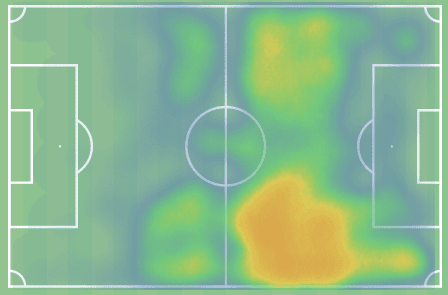
Figure 1 shows Adli’s heatmap for the 2020/21 season. Here, we see that the attacker has spent the majority of his time on the right-wing and in the right half-space. Despite mostly playing as a right centre-forward, he actually doesn’t spend a lot of time inside the penalty area.
While we see some colour high up on the right-wing, it’s clear from observing Adli’s performances this term for Toulouse and from this heatmap that he prefers to play in deeper areas on the right side of the pitch and he rarely carries the ball out wide, along the sideline.
Adli is generally heavily involved in chance creation both in the middle and final third of the pitch, with the attacker occupying these areas a lot more than central positions inside the box. He likes to receive the ball just inside of the opposition’s half or just inside the final third. As we’ll discuss later, he’s good at finding space in this area from where he can turn and either carry the ball into a more dangerous position or play in a teammate via a through ball.
Adli’s movement in the final third and shooting
Adli’s seven Ligue 2 goals this term make him Toulouse’s third-highest league goalscorer at present. So, how does this attacker typically score his goals? And how have Toulouse managed to get him firing so frequently this season?
To answer this, we’ve analysed the player’s movement in the final third, what kind of chances he typically gets and how he tends to fare when he’s on the end of specific types of chances.
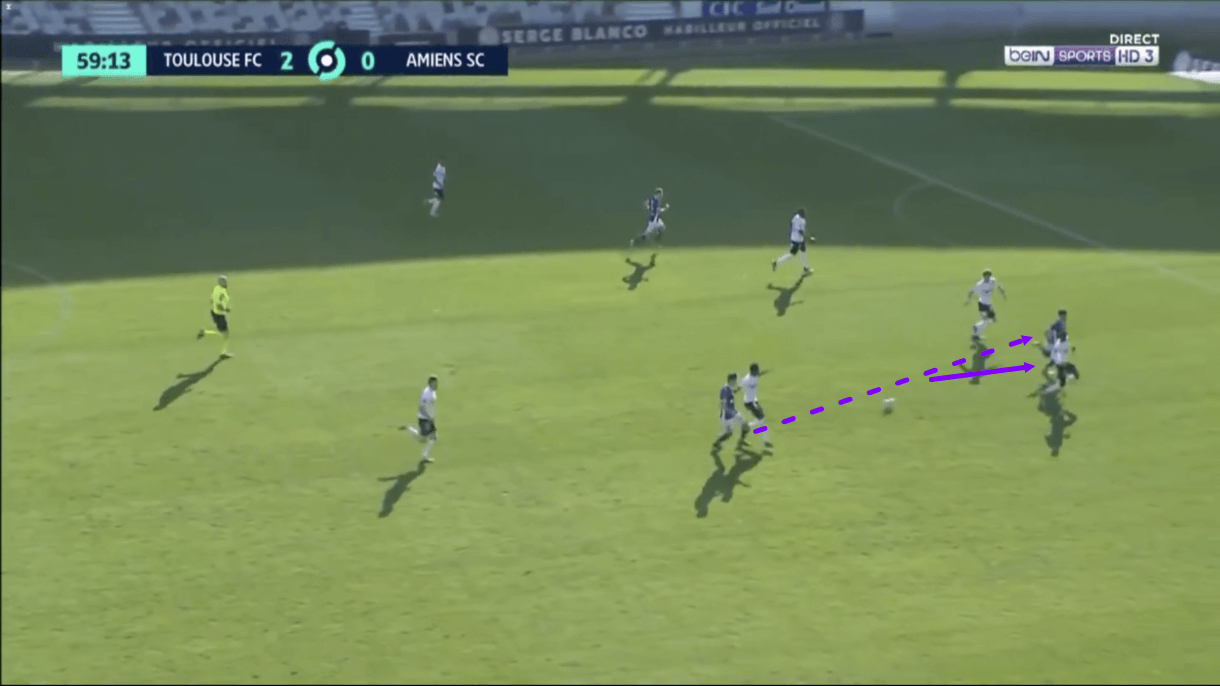
Figure 2 shows Adli making a run in behind the opposition’s backline to get onto the end of his teammate’s through ball. We see him looking over his shoulder to observe the movement of the ball briefly before positioning his body well to receive this pass and continue his run in behind the backline, increasing the space between himself and the defenders.
Here, Adli is running in the channel between the opposition’s left centre-back and left-back. This is an area that he targets with his runs in the right centre-forward position. In this position, he likes to force the opposition’s defenders to make a decision, either pulling the centre-back out wider than he’d like to be, pulling the full-back in narrower than he’d like to be or enjoying more space in between these players than the opposition would like him to have.
From the right, Adli prefers the through ball to be played on his inside, which is why he gets himself closer to the full-back here, creating more space between him and the left centre-back for this pass to go through.
The 20-year-old wants the ball played on his inside because he can take it into his stride and set up a shot on the inside of his stronger left foot more easily than if the ball was played on the outside and he had to try and shift the ball from the outside to the inside and onto his stronger foot. So, this example shows one of the best ways for Adli to receive the ball in the final third.
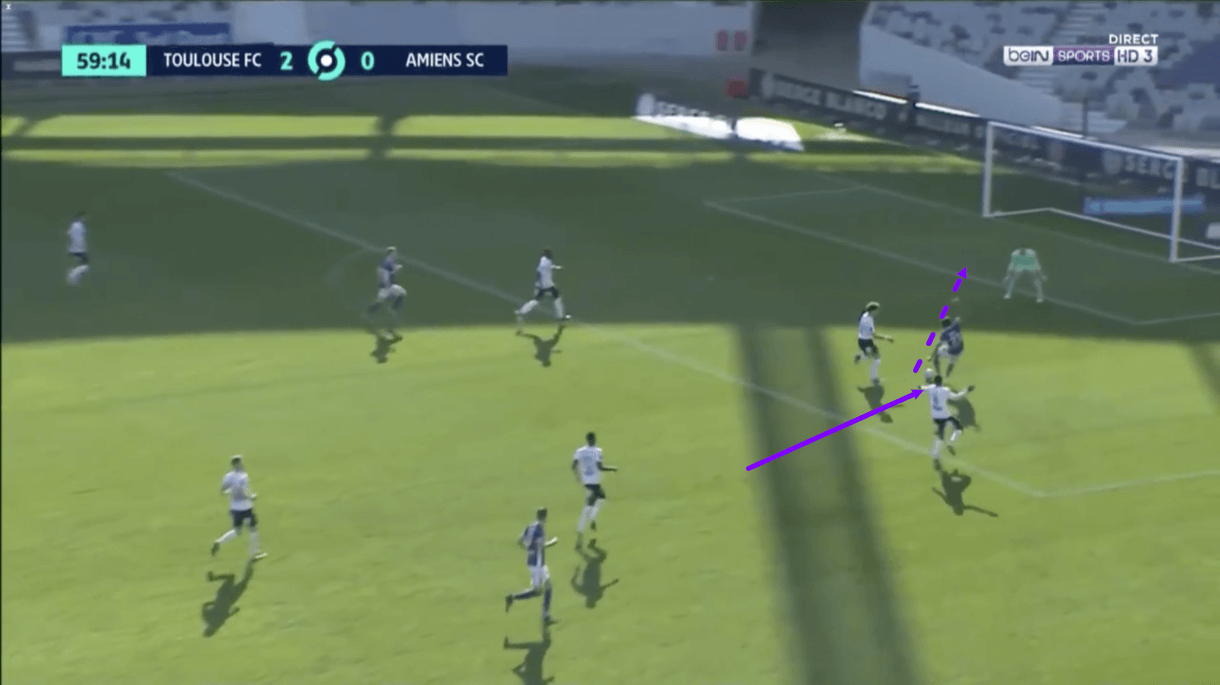
As play moves on, figure 3 shows us how Adli succeeded at taking the ball in his stride without sacrificing pace, bringing it into the box and creating a dangerous shooting angle on his left foot. He manages to get a shot off with the inside of his left foot but the goalkeeper positioned himself and anticipated the forward’s intentions well, pulling off a save. Adli has scored goals from this shooting scenario this season and he tends to be very dangerous when played through like this.
Adli presents a significant threat in behind the opposition’s backline thanks to his intelligent movement and his pace, he likes to shoot with the inside of his stronger foot from a slight angle.

In figure 4, we see Adli in a 1v1 with the opposition’s goalkeeper. Here, the striker is hitting his shot from a central position.
This is an example of a shot resulting from Adli’s counterattacking threat. Shortly before this image, Toulouse’s opponents, Troyes, were in possession of the ball in the middle third but Les Violets won the ball back just inside of their own half.
As Toulouse began their counterattack, Adli made a run from his right centre-forward position across the opposition backline, keeping himself onside and threatening Troyes’ backline, which was positioned quite high as a result of them having just been building an attack.
The attacker got onto the end of a ball that was played through the centre of the pitch and that, with the help of his pace, set him up for a 1v1 on his stronger left foot in a central position. As play moves on, Adli slots this one away coolly to the near post.
This attack shows how Adli’s pace and ability to time his runs combine to make him a threat on the counter for Toulouse.
Adli tends to do very well in shooting scenarios like this, as he is generally very composed in front of goal. If presented a 1v1 versus the opposition ‘keeper and given time to pick his spot in the goal, he is a reliable finisher.
In contrast, Adli has not performed as well when given less time to line up his shot, even from close-range. This has seen him misplace shots from low crosses and rebounds.
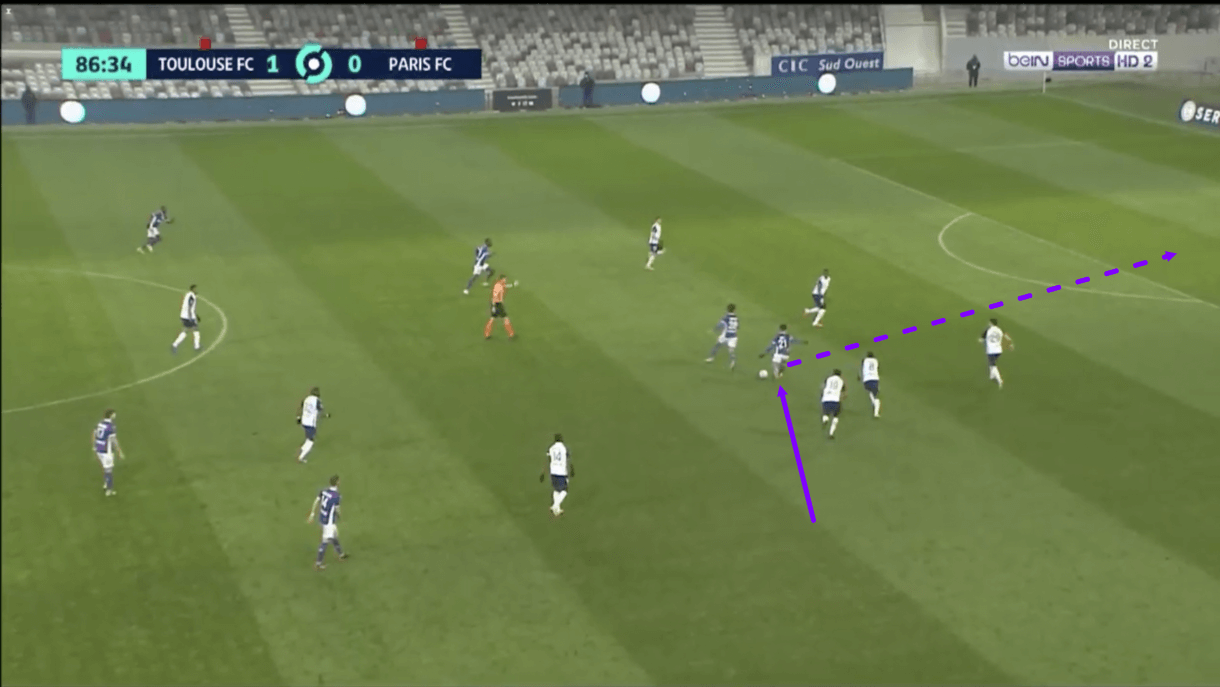
Another area where Adli can improve is with his shot selection. At times, he snatches at shooting opportunities, as was the case in figure 5, where he has just cut in from the right-wing and takes the opportunity to shoot from distance. There is some room for improvement with Adli’s decision-making in terms of when and when not to take on longshots, as occurrences like this happen far too often.
Adli is capable of hitting very good long shots, however, he takes shots like this where he’s at a considerable distance from goal and not at a great shooting angle to the ball far too often, especially when he can carry the ball closer to goal or link up with a teammate to play the ball closer to the goal. As play moves on, Adli’s shot fails to test the ‘keeper and this attack is essentially wasted.
Adli’s dribbling ability
Dribbling is a prominent area of Adli’s game, he spends a lot of his time taking on opposition defenders and carrying the ball upfield to try and put his team in a more advantageous position. In fact, Adli is the most prolific dribbler in Toulouse’s first-team, making 7.48 dribbles per 90 in Ligue 2 this season – more than any other Toulouse player and the ninth-most dribbles of any player in France’s second-tier. Meanwhile, Adli has also made the 18th-most progressive runs per 90 (2.93) of any Ligue 2 player this term.
Adli often attempts to draw fouls out of the opposition. He looks to get fouled very often and he succeeds at drawing fouls regularly. As a result, he’s been fouled 3.01 times per 90 this season, which is more than all but eight other players in Ligue 2, indicating just how tricky he can be on the ball and just how often he looks to draw fouls via his dribbling.
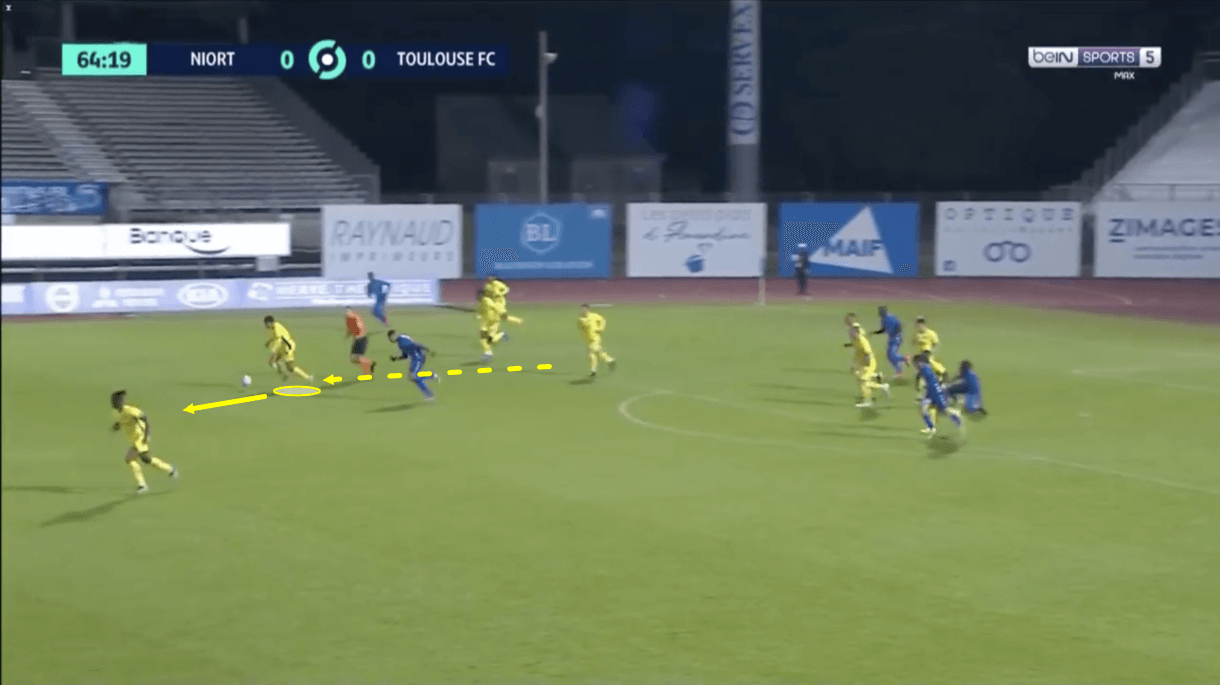
This aspect of his game can relieve pressure from his side and help them to regroup after they’ve defended an opposition attack. One example of this can be seen in figure 6. Just before this image, Toulouse cleared the ball out of their penalty area, finding Adli just outside the box. As he received the ball, the 20-year-old quickly turned towards the opposite end of the pitch and began carrying the ball upfield.
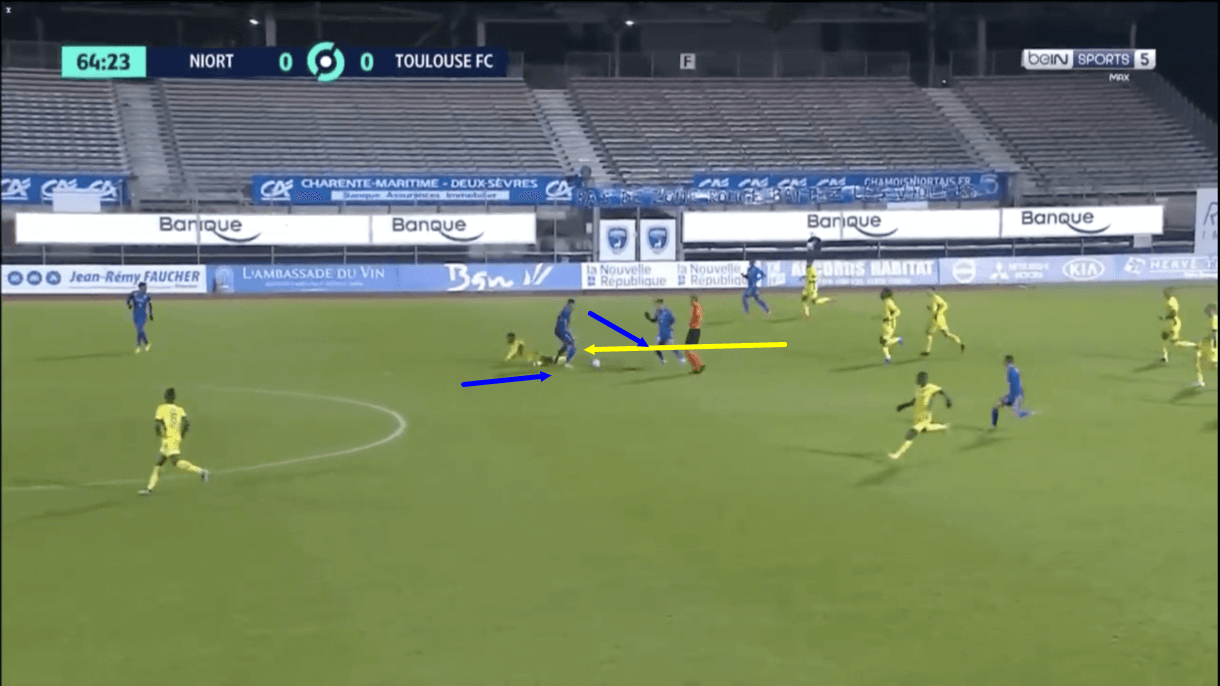
As play moves on and Adli progresses further upfield, he attracts pressure from two opposition players, one in front of him and one coming from his right, as we see in figure 7. As the player from his right closes in to make a tackle, the attacker uses his quick feet and agility to get the ball away from the defender, knocking it ahead of him. His tricky dribbling ability helps him to quickly pull off this move, while the opposing player doesn’t react to his movement quickly enough and as a result, he commits a foul, allowing Toulouse to regroup with a free-kick, ending this moment of pressure from the opposition.
It’s common to see Adli pulling off quick movements like this to get the ball out of the position that the opposition player is targeting with his tackle before that tackler has time to react and the fact that the Toulouse attacker is so good at doing this and attempts to do this so frequently is a big part of why he is among the top 10 most fouled players in Ligue 2 this season.
Adli’s dribbling can attract pressure from multiple opposition players and this can create space for his teammates. Adli can then pick out these teammates in extra space with a pass should he wish to do so, as he often does.
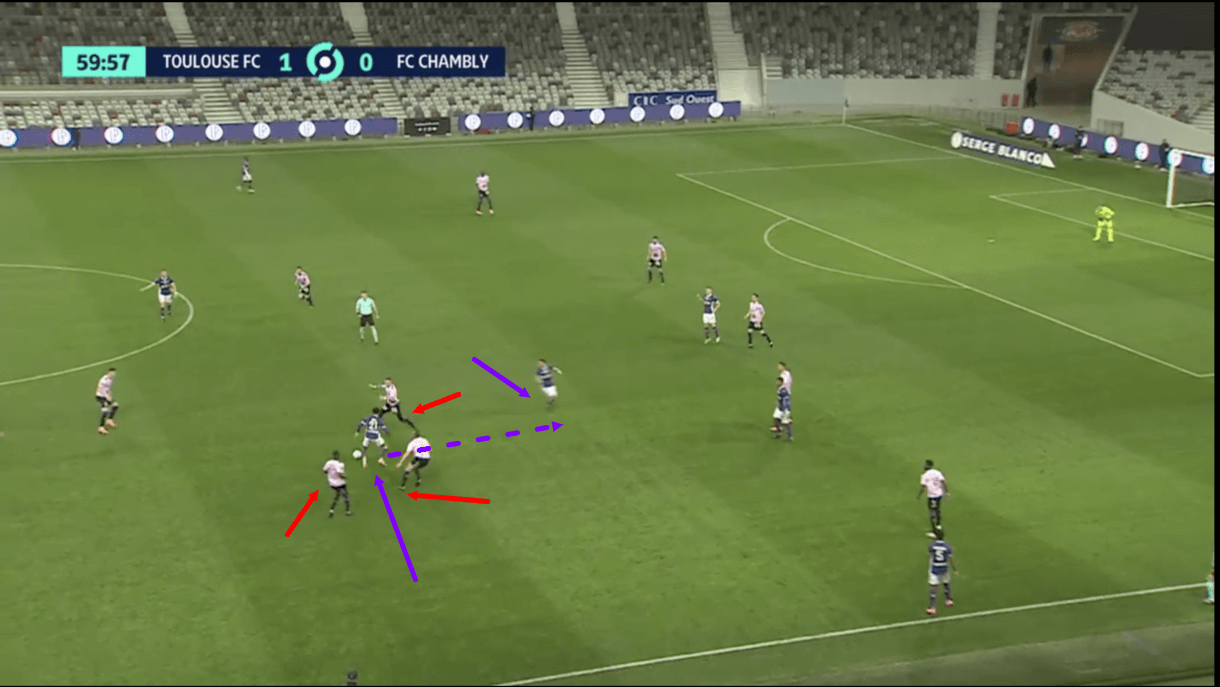
Figure 8 shows one such occasion where Adli picked out a teammate in a more advanced position and in more space than he’d be enjoying if Adli hadn’t attracted multiple opposition players towards him with his dribble.
Just before this image, Adli was positioned wide on the right-wing. He decides to cut inside into a more central position, keeping the ball on his stronger left foot as he drifts across the centre of the pitch. As he does so, he ends up being closely surrounded by three opposition players, two of whom are positioned ahead of him on the pitch.
One of Adli’s teammates shifts across the pitch in between the line featuring these two players pressing Adli from the front and the opposition backline.
Thanks to Adli occupying these two players in front of him and two even more advanced teammates occupying the nearest defenders in the backline behind him, this player enjoys a lot of space and Adli shows off his vision by spotting this movement, demonstrates his ability to hold onto the ball by giving the player time to get into this position and giving himself time to pick out the pass and demonstrates his forward passing quality, as he plays the ball in between the two defenders in front of him, picking out this teammate and putting his side in a better position.
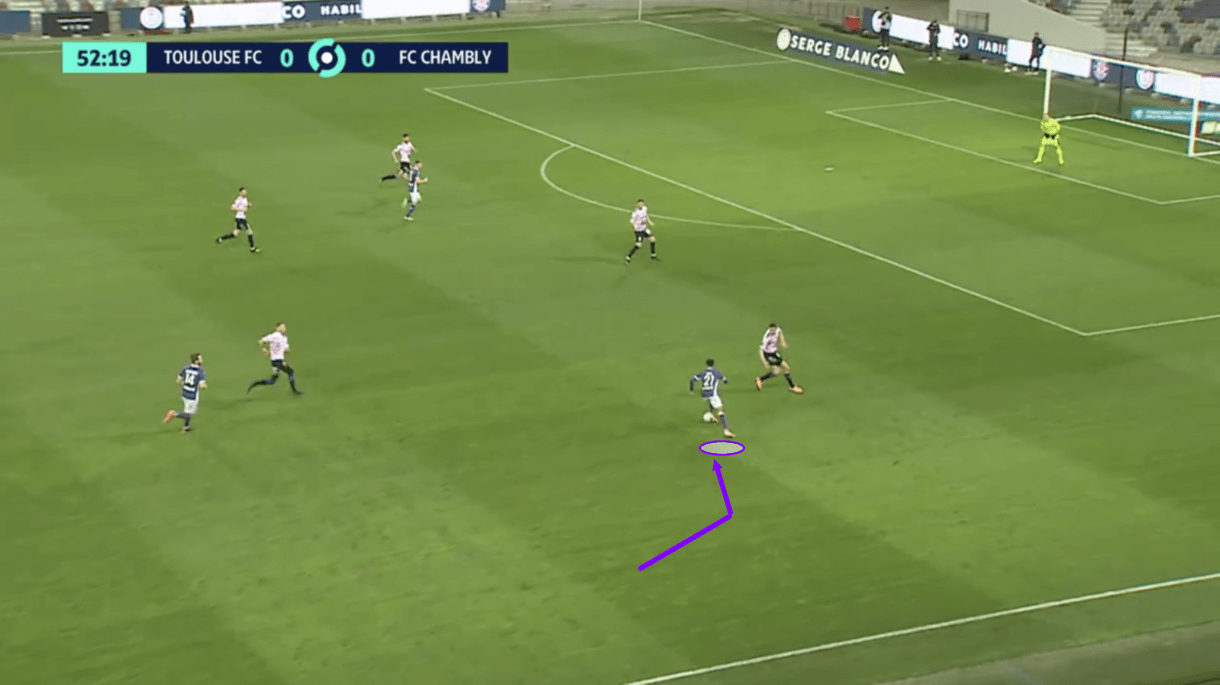
Lastly, we saw Adli cut inside from the right-wing into a more central position in the previous passage of play and we can see another example of this in figure 9, however, on this occasion, we see the attacker in a more advanced position, just inside the final third.
This is another very common movement to see Adli make. As we mentioned, he typically spends most of his time on the right side of the pitch, either on the wing or in the half-space. When he receives the ball in these positions, he rarely stays on the outside, progressing into a crossing position. Instead, we usually see him cut inside onto his favoured left foot, to either forge a shooting opportunity or play a through ball to a teammate ahead of him.
Adli’s through ball-playing ability
In the previous section of this tactical analysis, we saw Adli use his dribbling ability to create space for teammates and his vision to pick out forward passes. Another notable element of this attacker’s game and a key reason why he’s Toulouse’s joint-second-highest assist provider in the league is his through ball-playing ability.
Adli has played 1.67 through balls per 90 this season – the second-most of any Toulouse player. Additionally, he’s got a through ball success percentage of 43.9%, which is better than the team average of 35.6% and far better than the league average of 29.67%, indicating that the level of precision placed on his through balls is very good, despite him playing a relatively high number of them.
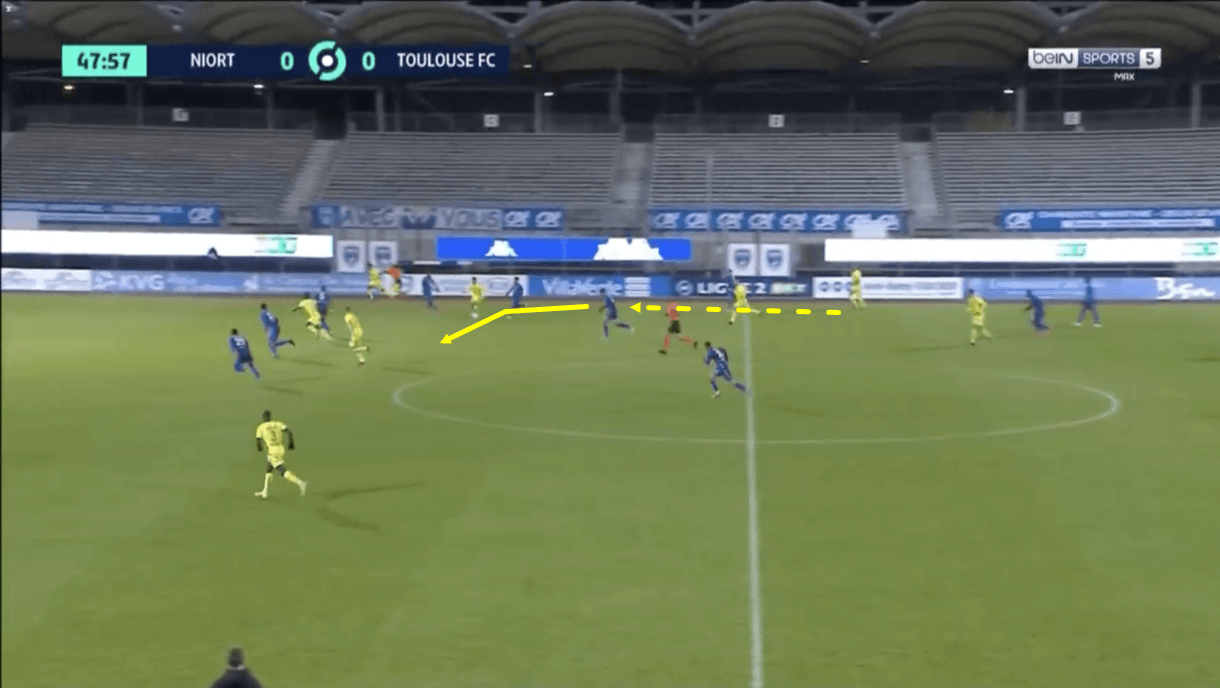
Before receiving a pass and playing a through ball, Adli has to find space to receive the ball in the first place. He often picks up the ball out wide on the right-wing, in or around the middle third of the pitch, as was the case in figure 10.
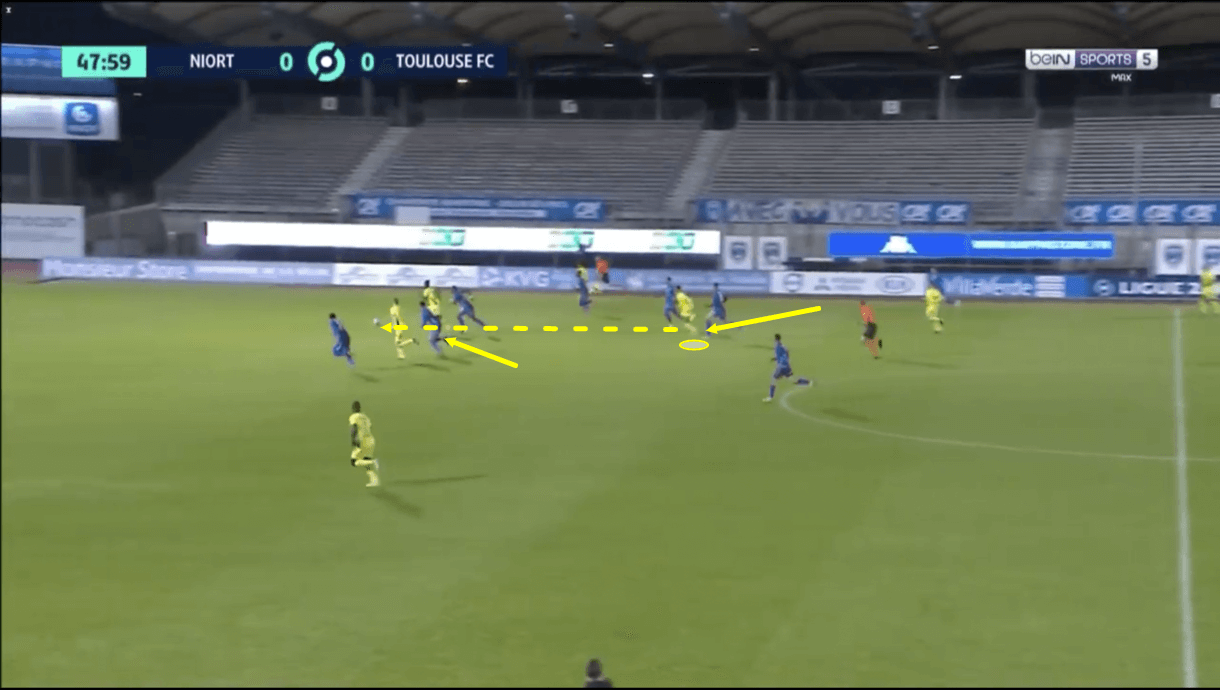
As play moves on and as figure 11 shows, the attacker goes on to carry the ball from this wide position into a more central area, as he often does. While carrying the ball into a central area, he attracts attention from the nearest opposition centre-back, who is also closest to the nearest attacker just ahead of Adli, who’s making a run in behind the opposition’s backline directly behind this centre-back who’s giving attention to Adli.
Adli goes on to quickly pick out this attacker’s run in behind this centre-back with a well-timed through ball. He didn’t carry the ball very far into the centre, just making a few steps while getting his head up and surveying the developing situation just ahead of him before playing his through ball and creating a dangerous situation for Toulouse.
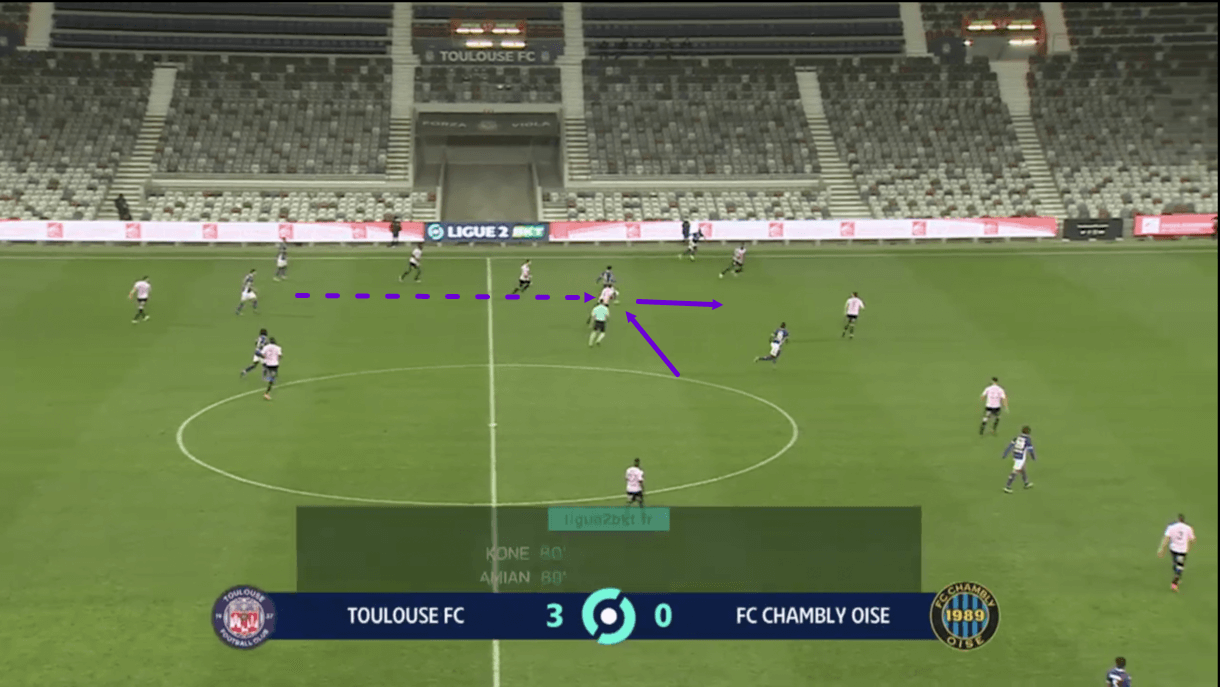
In figure 12, we see Adli finding space in between the lines again, however on this occasion, he’s occupying the left half-space, having just moved out there from a central position, spotting that there was enough space in this area to get on the ball and potentially cause problems.
Adli is very good at finding space all across the width of the pitch, in between the opposition’s midfield and defensive lines. His teammates are aware of this and the attacker’s constant movement in this area so they’re often looking for his movement in these positions to progress the ball upfield.
The 20-year-old generally receives the ball well in these positions, taking it on the half-turn, putting himself in a good position to either carry the ball upfield or relay the ball on again to a more advanced teammate via a through ball, essentially acting as a link man between the deep-lying Toulouse players and the furthest forward Toulouse players.
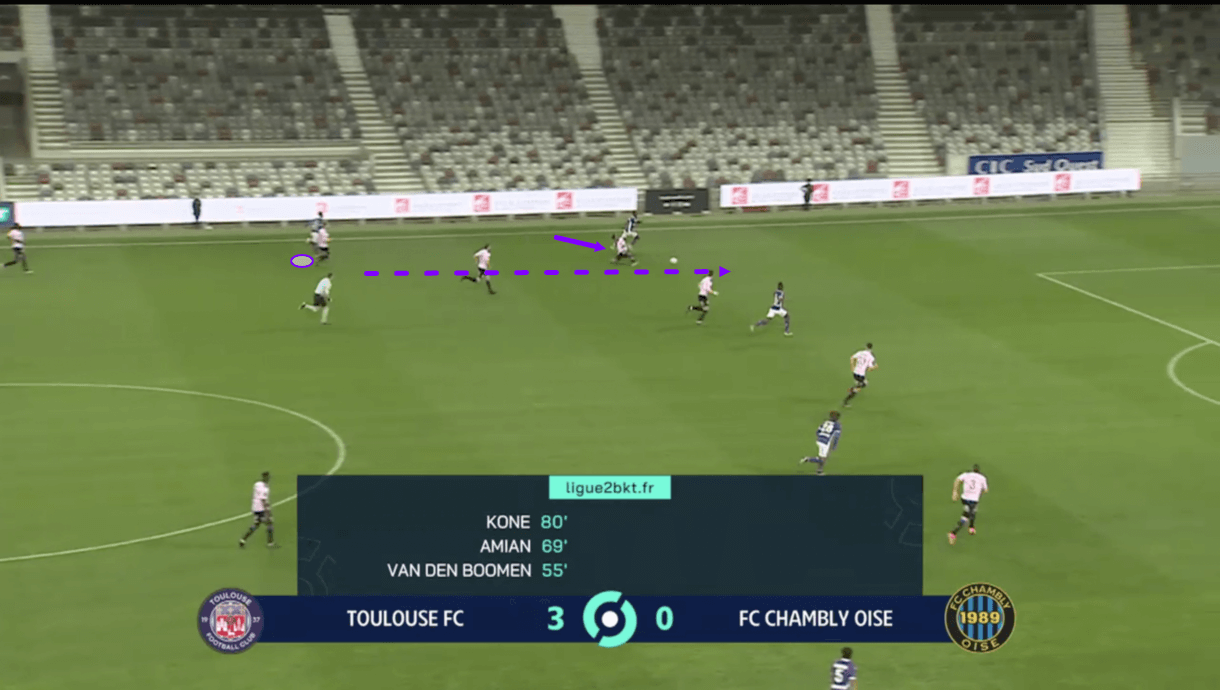
As this passage of play moves on, in figure 13, we see that Adli carried the ball upfield a few steps once again, as he did in the previous passage of play, attracting attention from the nearest defender to him, this time the opposition right-back, who has another Toulouse player running in behind him, who Adli picks out well with his through ball, setting Toulouse up inside the final third.
This highlights Adli’s dribbling quality and through ball-playing quality once again. He managed to play the ball just out of the opposition right-back’s reach, getting his side moving in behind the opposition backline.
So, it’s clear that Adli’s quality movement in between the lines, vision, dribbling quality – by way of how he tends to carry the ball forward somewhat, attracting attention before playing his through ball – and technical passing quality make him an effective playmaker.
Adli’s potential areas of improvement
We’ve looked at plenty of strengths and some weaknesses of Adli’s game throughout this tactical analysis. Now, we’re going to highlight another couple of potential areas of improvement in his game – his aerial ability and his defensive contribution.
Firstly, Adli, at 170cm and 60kg, is not a very big player physically. He’s not very small but he’s definitely not going to stand out for his height, while he also doesn’t have a very large frame nor is he extremely strong. This can be a weakness of his in physical battles on and off the ball, including with aerial duels.
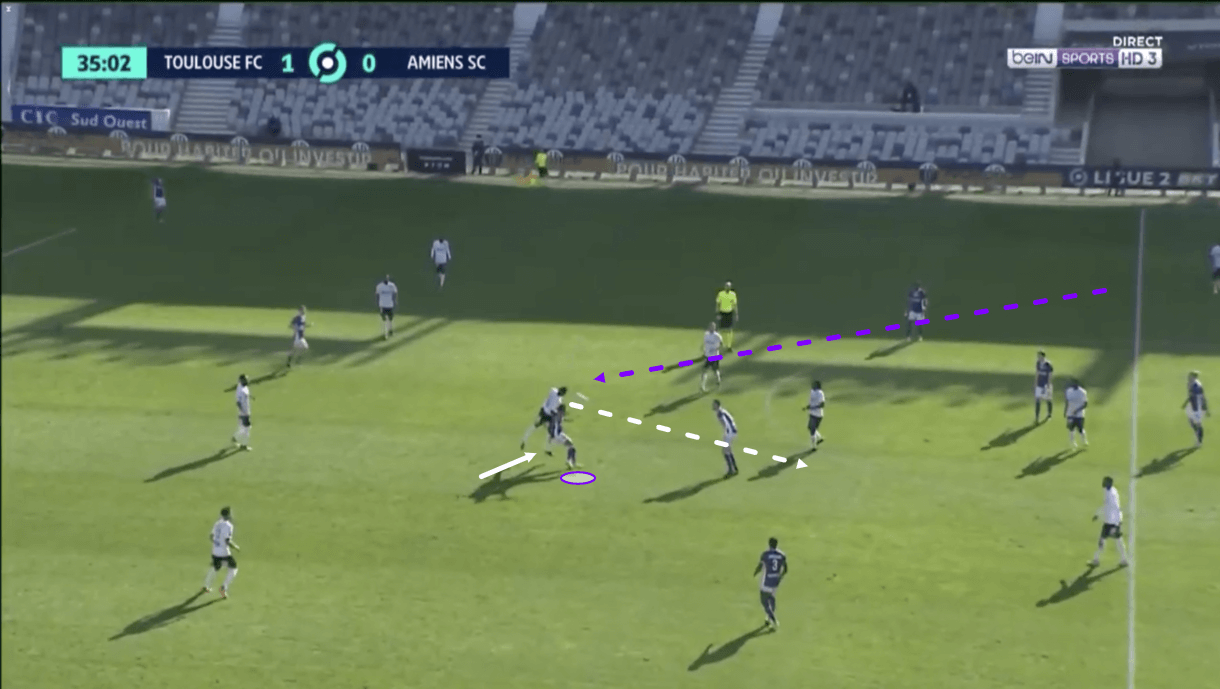
In figure 14, we see an example of Adli engaging in, and losing, an aerial duel. He was the target of a Toulouse goal kick here and ultimately ended up getting outjumped by an opposition player who had physical advantages on him in terms of size and strength. Adli attempted to back into this player to try and take the ball down but this attempt was thwarted by the opposition player who Adli failed to move and who ended up winning the aerial duel easily.
Adli isn’t terrible in the air but it isn’t usually difficult for opposition players to dominate him physically and the Toulouse attacker has only managed to win 42.68% of his aerial duels this season, which is lower than the team average of 49.8%, so this is an area where he could make some improvement.
As for Adli’s defensive contribution, as many as 15 Toulouse players have engaged in more defensive duels per 90 than Adli has this season and 18 other Toulouse players have made more interceptions than Adli this term.
Additionally, the 20-year-old has got a defensive duel success rate of 54.47%, which is lower than the team average of 59.2%. So, in addition to increasing his overall defensive output, perhaps Adli could become more efficient with the defensive action that he does commit, as he ranks relatively low in this area amongst his teammates.
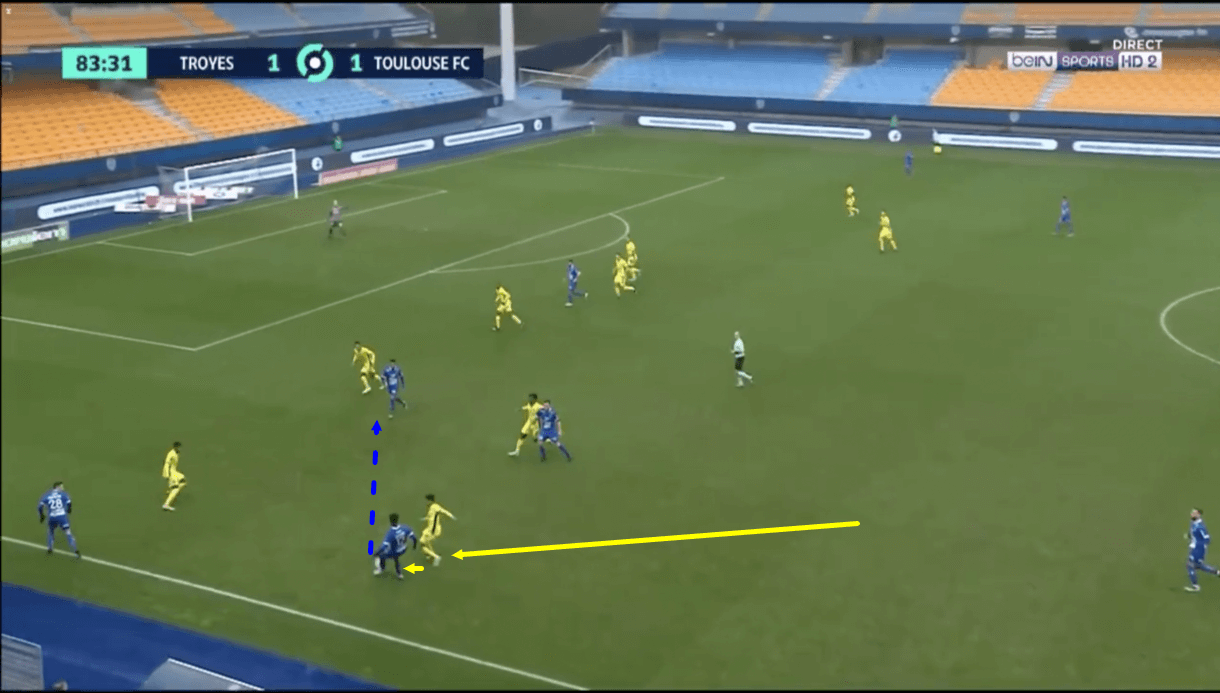
In figure 15, we see Adli tracking back to put in a challenge on the opposition’s left-back, who has carried the ball forward, however, perhaps giving Adli a taste of his own medicine, the Troyes man draws a foul out of the Toulouse attacker as he releases the ball before Adli gets to him but the Toulouse man still makes his challenge.
This isn’t an unusual sight, it’s also quite common to see Adli committing fouls off the ball as a result of poorly-timed challenges that come after the opposition player has released the ball. So, as well as his defensive output and his efficiency off the ball, perhaps Adli could try to cut down on diving into challenges unnecessarily, as he’s given away quite a few fouls this term like this.
Conclusion
To conclude our tactical analysis in the form of a scout report, we feel that Adli is one of a few very exciting prospects coming through at Toulouse this term who is primed to make the step up to Ligue 1 to compete with the likes of Lille, Lyon, Monaco and PSG, should Les Violets finish the job and bounce straight back to the top-flight for next season.
Thanks to his movement, dribbling quality and passing quality, the attacker is a very valuable playmaker for his side, often playing the role of a link man between the middle third and the final third, while he also tends to be a very reliable finisher in 1v1 situations where he has time to pick out his spot in the net to place the ball, though he can be less reliable when given less time to place his finish.
Adli can improve in terms of his physicality, his aerial ability and his defensive contribution but overall, we feel he has a lot of positives to his game that make him one of the most exciting young talents that Ligue 2 – a renowned hub of promising talent bursting onto the scene, similar to other second-tiers around Europe such as the EFL Championship and the German 2. Bundesliga – has to offer at present.





Comments